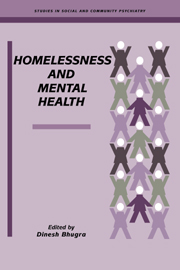Book contents
- Frontmatter
- Contents
- List of contributors
- Preface
- Part I INTRODCTION AND SPECIAL GROUPS
- Part II SERVICES
- Part III INTERNATIONAL PERSPECTIVE
- Part IV POLICY AND EVALUATION
- 15 Implications of social policy
- 16 Evaluating services for homeless people with mental disorders: theoretical and practical issues
- 17 Future directions for homeless mentally ill
- Index
17 - Future directions for homeless mentally ill
from Part IV - POLICY AND EVALUATION
Published online by Cambridge University Press: 15 October 2009
- Frontmatter
- Contents
- List of contributors
- Preface
- Part I INTRODCTION AND SPECIAL GROUPS
- Part II SERVICES
- Part III INTERNATIONAL PERSPECTIVE
- Part IV POLICY AND EVALUATION
- 15 Implications of social policy
- 16 Evaluating services for homeless people with mental disorders: theoretical and practical issues
- 17 Future directions for homeless mentally ill
- Index
Summary
The lessons from a literature review from around the world suggest that the definitions of homelessness vary but the association between homelessness and chronic severe mental illness is fairly well known. The health services also vary according to the local socio-economic and political structures, which means that the true assessment of actual numbers of the homeless and their needs presents a major problem. In the UK, localized catchment area based community services may enable a closer primary and secondary care interface as described in Chapter 11. In the USA, marked reduction in low-cost housing and deinstitutionalization of state and county mental hospitals have contributed to the problem of social construction of homelessness (Robertson & Greenblatt, 1992). The global view, not comprehensive by any means, outlined in this volume suggests that there are common themes for research, management and social policy change and that there are also differences in terms of definitions of poverty and homelessness, which may be inextricably linked, and also in terms of service provision. If any strategies for change in research, social policy and management are to succeed there have to be concentrated efforts on the part of the researchers, clinicians, policy makers and politicians. As the causes of homelessness are multi-dimensional, their management as well as social policy changes must be multi-factorial and multi-dimensional.
Commonalities across the globe
There are common confusions regarding definitions of homelessness, how people enter the spiral of homelessness and associations with mental ill-health and vulnerability factors for physical illness.
Definitions
Many policy makers seem to think that the homeless are a homogeneous group.
- Type
- Chapter
- Information
- Homelessness and Mental Health , pp. 297 - 306Publisher: Cambridge University PressPrint publication year: 1996



